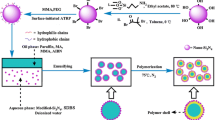Abstract
This work deals with the synthesis and physico-chemical characterization of nanoencapsulated paraffin wax with polyurethane (PU) via interfacial polymerization method. In synthesized nanocapsules, the paraffin wax has a function of phase change material, while PU acts as a shell material. The nanoencapsulated PCMs were characterized chemically and morphologically by using Fourier transform infrared (FTIR) spectroscopy and scanning electron microscopy (SEM). The results of morphological study showed that the particle size distribution of the nanocapsules were 80–400 nm by digimizer analysis.
Access provided by Autonomous University of Puebla. Download conference paper PDF
Similar content being viewed by others
Keywords
1 Introduction
The application of the heat storage system with use of phase change material is an effective way to save energy [1]. Phase change materials (PCMs) as a kind of crystalline materials, can store and release latent heat during their phase transition at a defined temperature range, which can be used in thermal energy conservation [2]. Paraffin wax is especially promising due to their characteristics such as nontoxic, chemically inert, low cost, and tunable phase change temperature and high storage energy capacity [3]. In order to prevent melt flowing during solid-liquid phase transition, encapsulation of PCMs with proper materials as shell is required [2]. This paper considers the synthesis of nanoencapsulation of phase change material, paraffin wax as a core and polyurethane shell material by in-situ inter-phase polymerization.
2 Experimental
2.1 Materials
Commercial novolac resin (IP 502 Resitan Co. Iran) as a polyol and toluene diisocyanate (Merck Co. Germany) were used as precursors to form the shell. Acetone (Dr. Mojallali Co. Iran) was used as solvent. Paraffin wax was purchased from Dr. Mojallali Co. Iran and used as phase change material.
2.2 Synthesis of Nanocapsules
The encapsulation of the paraffin wax was carried out by interfacial polymerization method. For this propose; First, 0.1 g of nano particles of paraffin wax, which synthesized using solvent-anti solvent method in Tarbiat Modares University Lab, have smeared to a dozen of drops of toluene diisocyanate for 18 h. Second, 40 mL of acetone was added to the previous step and sonicated for 10 min. Third, 0.5 g of novolac were dissolved in 10 mL of acetone and added to the second step. At the end, the polycondensation polymerization reaction was done at 30 °C for 20 h.
2.3 Characterization
FTIR spectroscopy (FTIR, PerkinElmer, Frontier, USA) was applied to characterize the chemical structures of the samples using a KBr sampling sheet.
The morphology of the nanocapsule samples were investigated by using a scanning electron microscopy (SEM, xl30, Philips, Japan).
3 Results and Discussion
3.1 Morphology Analysis
The SEM images of the nanoencapsulated PCM are shown in Fig. 1. It can be seen that, most of the nanocapsules are smooth spherical shape, compact surface and regular. Also, most nanocapsules fell in the range of 80–400 nm, this was consistent with the result from the digimizer analysis (Fig. 3).
3.2 Chemical Structure Analysis
The FT-IR spectral analysis was used to confirm the formation of PU (polyurethane) shell around the paraffin wax. The FTIR spectral results of pure paraffin wax, PU and nanocapsules are shown in Fig. 2. The presence of the peak 1740 cm−1 (urethane group) in the FTIR of PU and nanocapsules was indicated that consisted the urethane groups. It is proved that, the paraffin wax was successfully encapsulated by PU shell material.
4 Conclusion
Nanoencapsulation containing paraffin wax as a core material and PU shell material were successfully synthesized by interfacial polymerization method. The polymerization reactions regarding with the formation of PU shell around the paraffin wax were confirmed via the FTIR spectroscopy technique. The SEM analysis showed that the prepared capsules had virtually a smooth and compact surface and spherical shape.
References
Zalba, B., Marin, J.M., Cabeza, L.F., Mehling, H.: Appl. Therm. Eng. J. 23, 251–283 (2003)
Himran, S., Suwono, A., Mansoori, G.A.: Energy Sour. J. 18, 16–117 (2004)
Shchukina, E.M., Graham, M., Zheng, Z., Shchukin, D.G.: R. Soc. Chem. J. 47, 4156–4175 (2018)
Author information
Authors and Affiliations
Corresponding author
Editor information
Editors and Affiliations
Rights and permissions
Copyright information
© 2020 Springer Nature Switzerland AG
About this paper
Cite this paper
Nikpourian, H., Bahramian, A.R., Abdollahi, M. (2020). Synthesis of Paraffin Wax Phase Change Material Nanoencapsulated by Polyurethane via Interfacial Polymerization. In: Mirzadeh, H., Katbab, A. (eds) Eco-friendly and Smart Polymer Systems. ISPST 2018. Springer, Cham. https://doi.org/10.1007/978-3-030-45085-4_47
Download citation
DOI: https://doi.org/10.1007/978-3-030-45085-4_47
Published:
Publisher Name: Springer, Cham
Print ISBN: 978-3-030-45084-7
Online ISBN: 978-3-030-45085-4
eBook Packages: Chemistry and Materials ScienceChemistry and Material Science (R0)







